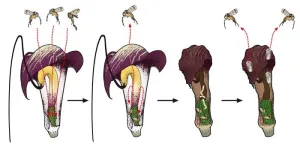(Press-News.org) February 19, 2024, Cleveland: Cleveland Clinic researchers have identified a new pathway that contributes to cardiovascular disease associated with high levels of niacin, a common B vitamin previously recommended to lower cholesterol.
The team, led by Stanley Hazen, M.D., Ph.D., discovered a link between 4PY, a breakdown product from excess niacin, and heart disease. Higher circulating levels of 4PY were strongly associated with development of heart attack, stroke and other adverse cardiac events in large-scale clinical studies. The researchers also showed in preclinical studies that 4PY directly triggers vascular inflammation which damages blood vessels and can lead to atherosclerosis over time.
The study, published in Nature Medicine, also details genetic links between 4PY and vascular inflammation. The findings provide a foundation for potential new interventions and therapeutics to reduce or prevent that inflammation.
“What’s exciting about these results is that this pathway appears to be a previously unrecognized yet significant contributor to the development of cardiovascular disease,” said Dr. Hazen, Chair of Cardiovascular and Metabolic Sciences at Cleveland Clinic’s Lerner Research Institute and Co-Section Head of Preventive Cardiology in the Heart, Vascular & Thoracic Institute. “What’s more, we can measure it, meaning there is potential for diagnostic testing. These insights set the stage for developing new approaches to counteract the effects of this pathway.”
Niacin (vitamin B-3) is very common in a Western diet. “For decades, the United States and more than 50 nations have mandated niacin fortification in staple foods such as flour, cereals and oats to prevent disease related to nutritional deficiency,” said Dr. Hazen. Yet one in four subjects in the researchers’ patient cohorts appear to be getting too much, and had high levels of 4PY, which appears to contribute to cardiovascular disease development.
Dr. Hazen compares our intake of niacin as multiple taps pouring water into a bucket. Once that bucket is filled, it begins to spill over. The human body then needs to process that spill-over and produce other metabolites, including 4PY.
“The main takeaway is not that we should cut out our entire intake of niacin – that’s not a realistic approach,” said Dr. Hazen. “Given these findings, a discussion over whether a continued mandate of flour and cereal fortification with niacin in the U.S. could be warranted.”
Dr. Hazen notes broader use of over-the-counter supplements made with different forms of niacin have also become popular because of presumed anti-aging purposes. He adds that patients should consult with their doctors before taking over-the-counter supplements and focus on a diet rich in fruit and vegetables while avoiding excess carbohydrates.
The new findings also might help explain why niacin is no longer a go-to treatment for lowering cholesterol. Niacin was one of the first treatments prescribed to lower LDL or “bad” cholesterol. However, eventually niacin showed to be less effective than other cholesterol-lowering drugs and was associated with other negative effects and higher mortality rates in previous research.
“Niacin’s effects have always been somewhat of a paradox,” Dr. Hazen said. “Despite niacin lowering of cholesterol, the clinical benefits have always been less than anticipated based on the degree of LDL reduction. This led to the idea that excess niacin caused unclear adverse effects that partially counteracted the benefits of LDL lowering. We believe our findings help explain this paradox. This illustrates why investigating residual cardiovascular risk is so critical; we learn so much more than what we set out to find.”
The study authors note that long-term investigations are needed to assess the effect of chronic elevation of 4PY levels on atherosclerosis and other phenotypes.
The research is part of Dr. Hazen’s ongoing investigation into factors that contribute to residual cardiovascular risk. His team follows patients over time and collects blood samples to find chemical signatures that can predict the development of heart disease. He has made pioneering discoveries in atherosclerosis and inflammatory disease research, including the seminal discovery linking gut microbial pathways to cardiovascular disease and metabolic diseases.
Dr. Hazen also directs Cleveland Clinic’s Center for Microbiome and Human Health and holds the Jan Bleeksma Chair in Vascular Cell Biology and Atherosclerosis.
Marc Ferrell, a former M.D., Ph.D. student in Dr. Hazen’s laboratory and student in Case Western Reserve University’s Medical Scientist Training Program, is first author of the manuscript. Research reported in this publication was supported in part by the National Institutes of Health under award numbers R01HL103866, P01HL147823, R01HL133169, R01HL148110, R01HL168493, and U54HL170326.
February 19, 2024, Cleveland: Cleveland Clinic researchers have identified a new pathway that contributes to cardiovascular disease associated with high levels of niacin, a common B vitamin previously recommended to lower cholesterol.
The team, led by Stanley Hazen, M.D., Ph.D., discovered a link between 4PY, a breakdown product from excess niacin, and heart disease. Higher circulating levels of 4PY were strongly associated with development of heart attack, stroke and other adverse cardiac events in large-scale clinical studies. The researchers also showed in preclinical studies that 4PY directly triggers vascular inflammation which damages blood vessels and can lead to atherosclerosis over time.
The study, published in Nature Medicine, also details genetic links between 4PY and vascular inflammation. The findings provide a foundation for potential new interventions and therapeutics to reduce or prevent that inflammation.
“What’s exciting about these results is that this pathway appears to be a previously unrecognized yet significant contributor to the development of cardiovascular disease,” said Dr. Hazen, Chair of Cardiovascular and Metabolic Sciences at Cleveland Clinic’s Lerner Research Institute and Co-Section Head of Preventive Cardiology in the Heart, Vascular & Thoracic Institute. “What’s more, we can measure it, meaning there is potential for diagnostic testing. These insights set the stage for developing new approaches to counteract the effects of this pathway.”
Niacin (vitamin B-3) is very common in a Western diet. “For decades, the United States and more than 50 nations have mandated niacin fortification in staple foods such as flour, cereals and oats to prevent disease related to nutritional deficiency,” said Dr. Hazen. Yet one in four subjects in the researchers’ patient cohorts appear to be getting too much, and had high levels of 4PY, which appears to contribute to cardiovascular disease development.
Dr. Hazen compares our intake of niacin as multiple taps pouring water into a bucket. Once that bucket is filled, it begins to spill over. The human body then needs to process that spill-over and produce other metabolites, including 4PY.
“The main takeaway is not that we should cut out our entire intake of niacin – that’s not a realistic approach,” said Dr. Hazen. “Given these findings, a discussion over whether a continued mandate of flour and cereal fortification with niacin in the U.S. could be warranted.”
Dr. Hazen notes broader use of over-the-counter supplements made with different forms of niacin have also become popular because of presumed anti-aging purposes. He adds that patients should consult with their doctors before taking over-the-counter supplements and focus on a diet rich in fruit and vegetables while avoiding excess carbohydrates.
The new findings also might help explain why niacin is no longer a go-to treatment for lowering cholesterol. Niacin was one of the first treatments prescribed to lower LDL or “bad” cholesterol. However, eventually niacin showed to be less effective than other cholesterol-lowering drugs and was associated with other negative effects and higher mortality rates in previous research.
“Niacin’s effects have always been somewhat of a paradox,” Dr. Hazen said. “Despite niacin lowering of cholesterol, the clinical benefits have always been less than anticipated based on the degree of LDL reduction. This led to the idea that excess niacin caused unclear adverse effects that partially counteracted the benefits of LDL lowering. We believe our findings help explain this paradox. This illustrates why investigating residual cardiovascular risk is so critical; we learn so much more than what we set out to find.”
The study authors note that long-term investigations are needed to assess the effect of chronic elevation of 4PY levels on atherosclerosis and other phenotypes.
The research is part of Dr. Hazen’s ongoing investigation into factors that contribute to residual cardiovascular risk. His team follows patients over time and collects blood samples to find chemical signatures that can predict the development of heart disease. He has made pioneering discoveries in atherosclerosis and inflammatory disease research, including the seminal discovery linking gut microbial pathways to cardiovascular disease and metabolic diseases.
Dr. Hazen also directs Cleveland Clinic’s Center for Microbiome and Human Health and holds the Jan Bleeksma Chair in Vascular Cell Biology and Atherosclerosis.
Marc Ferrell, a former M.D., Ph.D. student in Dr. Hazen’s laboratory and student in Case Western Reserve University’s Medical Scientist Training Program, is first author of the manuscript. Research reported in this publication was supported in part by the National Institutes of Health under award numbers R01HL103866, P01HL147823, R01HL133169, R01HL148110, R01HL168493, and U54HL170326.
END
Cleveland Clinic-led study discovers link between high levels of niacin - a common b vitamin - and heart disease
Excess niacin fuels inflammation, cardiovascular disease through newly discovered pathway
2024-02-19
ELSE PRESS RELEASES FROM THIS DATE:
Neighborhood segregation and access to live donor kidney transplantation
2024-02-19
About The Study: Segregated residential and transplant center neighborhoods likely serve as a mechanism of structural racism, contributing to persistent racial disparities in access to live donor kidney transplantation. To promote equitable access, studies should assess targeted interventions (e.g., community outreach clinics) to improve support for potential candidates and donors and ultimately mitigate the effects of segregation.
Authors: Mara A. McAdams-DeMarco, Ph.D., of the New York University Grossman School of Medicine in New York, is the corresponding author.
To access the embargoed study: Visit our For The Media website at this link ...
Age-related risk of serious fall events and opioid analgesic use
2024-02-19
About The Study: The results of this study of 3.2 million people who initiated prescription opioid treatment suggest that prescription opioids were associated with increased risk of serious fall events among adults of all ages, with individuals 85 years or older at greatest risk. These risks should be considered when prescribing opioids, particularly for individuals with preexisting risk factors or when opioids are prescribed at higher doses. Targeted falls prevention efforts may be most effective within the first month following opioid initiation.
Authors: Natasa Gisev, Ph.D., of the National Drug and Alcohol Research Centre, UNSW ...
Genetic risk prediction for 10 chronic diseases moves closer to the clinic
2024-02-19
By analyzing millions of small genetic differences across a person’s genome, researchers can calculate a polygenic risk score to estimate someone’s lifetime odds of developing a certain disease. Over the past decade, scientists have developed these risk scores for dozens of diseases, including heart disease, kidney disease, diabetes, and cancer, with the hope that patients could one day use this information to lower any heightened risk of disease. But determining whether such tests work effectively across all populations, and how they can guide clinical decision-making, has been a challenge.
Now, ...
Newly discovered genetic markers help pinpoint diabetes risks, complications
2024-02-19
In the largest genome-wide association study to date on Type 2 diabetes, a team of international researchers, co-led by a University of Massachusetts Amherst genetic epidemiologist, has located 1,289 genetic markers associated with Type 2 diabetes (145 of which are newly identified) and generated risk scores for diabetes complications.
In research published Monday, Feb. 19 in the journal Nature that advances understanding into the inheritability of Type 2 diabetes, the scientists used cutting-edge ...
One step forward, no steps back: new study advances understanding of dopamine’s role in movement
2024-02-19
Dopamine, a chemical messenger in the brain, is mostly known for its role in how we experience pleasure and reward. However, new research from the Champalimaud Foundation (CF) shifts the spotlight towards dopamine’s critical involvement in movement, with implications for our understanding and treatment of symptoms in Parkinson’s Disease (PD).
Imagine the act of walking. It’s something most able-bodied people do without a second thought. Yet it is actually a complex process involving various ...
Pollinator's death trap turns into nursery
2024-02-19
In a group of plants that is famous for luring its pollinators into a death trap, one species offers its flowers as a nursery in exchange. The Kobe University discovery blurs the line between mutualism and parasitism and sheds light on the evolution of complex plant-insect interactions.
Many plants rely on animals for pollination and most offer rewards for the service. Some plants, however, deceive their pollinators, and a famous example is the genus Arisaema. “It is famous as the only plant that achieves pollination at the expense of the pollinator's life,” says Kobe University biologist SUETSUGU Kenji, who is an expert on plant pollination ecology. The plant uses ...
Studies find flu vaccines were effective in 2022-2023 flu season
2024-02-19
The prospect of the worrisome triple threat of COVID, RSV and flu was assuaged last year by the effectiveness of flu vaccines. Two recent studies from the Centers for Disease Control and Prevention’s VISION Network have found that flu vaccines were effective for all ages against both moderate and severe flu in the U.S. during the 2022-2023 flu season.
Both the pediatric and adult VISION Network studies analyzed flu-associated emergency department (E.D.)/urgent care visits (indicative of moderate disease) and hospitalization (indicative of severe disease) from October 2022 through March 2023, a flu season in which far fewer individuals were social distancing or ...
Second year of Cal Poly astronomy fellowship to examine high-energy particle jets near supermassive black holes
2024-02-19
February 16, 2024
Contact: Nick Wilson
805-235-8008; nwilso28@calpoly.edu
Second Year of Cal Poly Astronomy Fellowship to Examine High-Energy Particle Jets Near Supermassive Black Holes
SAN LUIS OBISPO — In the second year of the Astronomy Faculty Research Fellowship in Cal Poly’s Bailey College of Science and Mathematics, a research team will study extremely high-energy photons emitted by the extreme environment found near mega-sized black holes.
The fellowship was ...
To boost a preschooler’s language skills, consider reminiscing
2024-02-19
Language skills are strong predictors of academic, socioemotional and behavioral outcomes when children enter school. They learn language in preschool years by interacting with others, especially their parents. Book sharing is a popular way parents engage young children in conversation. However, not all parents are comfortable with book sharing and not all children like having books read to them.
A new study on “parent talk” by Florida Atlantic University, in collaboration with Aarhus University in Denmark, provides ...
Husker team wins prize in contest to treat disease through gene editing
2024-02-19
Lincoln, Nebraska, Feb. 19, 2024 — A Husker research duo was named a first-round winner in a National Institutes of Health competition aimed at generating solutions for delivering genome-editing technology to the cells of people with rare and common diseases.
Janos Zempleni, Willa Cather Professor of molecular nutrition, and Jiantao Guo, professor of chemistry, were selected as Phase 1 winners in the NIH’s Targeted Genome Editor Delivery Challenge. The challenge is a three-phase competition with prizes totaling $6 million; the University of Nebraska–Lincoln team was among 30 initial recipients announced in December ...
LAST 30 PRESS RELEASES:
When is it time to jump? The boiling frog problem of AI use in physics education
Twitter data reveals partisan divide in understanding why pollen season's getting worse
AI is quick but risky for updating old software
Revolutionizing biosecurity: new multi-omics framework to transform invasive species management
From ancient herb to modern medicine: new review unveils the multi-targeted healing potential of Borago officinalis
Building a global scientific community: Biological Diversity Journal announces dual recruitment of Editorial Board and Youth Editorial Board members
Microbes that break down antibiotics help protect ecosystems under drug pollution
Smart biochar that remembers pollutants offers a new way to clean water and recycle biomass
Rice genes matter more than domestication in shaping plant microbiomes
Ticking time bomb: Some farmers report as many as 70 tick encounters over a 6-month period
Turning garden and crop waste into plastics
Scientists discover ‘platypus galaxies’ in the early universe
Seeing thyroid cancer in a new light: when AI meets label-free imaging in the operating room
Neutrophil-to-lymphocyte ratio may aid risk stratification in depressive disorder
2026 Seismological Society of America Annual Meeting
AI-powered ECG analysis offers promising path for early detection of chronic obstructive pulmonary disease, says Mount Sinai researchers
GIMM uncovers flaws in lab-grown heart cells and paves the way for improved treatments
Cracking the evolutionary code of sleep
Medications could help the aging brain cope with surgery, memory impairment
Back pain linked to worse sleep years later in men over 65, according to study
CDC urges ‘shared decision-making’ on some childhood vaccines; many unclear about what that means
New research finds that an ‘equal treatment’ approach to economic opportunity advertising can backfire
Researchers create shape-shifting, self-navigating microparticles
Science army mobilizes to map US soil microbiome
Researchers develop new tools to turn grain crops into biosensors
Do supervised consumption sites bring increased crime? Study suggests that’s a myth
New mass spec innovation could transform research
Maternal nativity, race, and ethnicity and infant mortality in the US
Migration-related trauma among asylum seekers exposed to the migrant protection protocols
Jupiter’s moon Europa has a seafloor that may be quiet and lifeless
[Press-News.org] Cleveland Clinic-led study discovers link between high levels of niacin - a common b vitamin - and heart diseaseExcess niacin fuels inflammation, cardiovascular disease through newly discovered pathway





